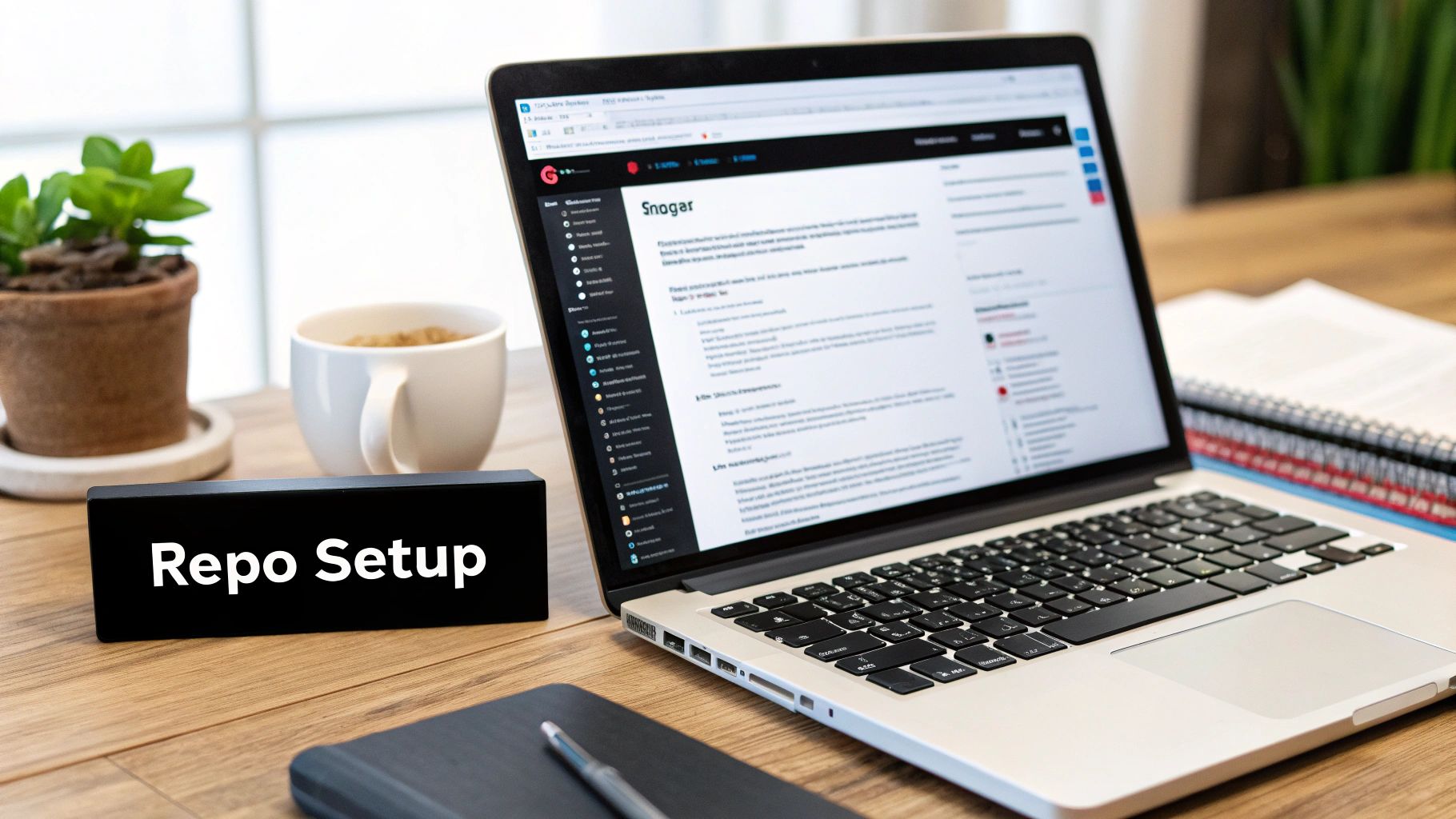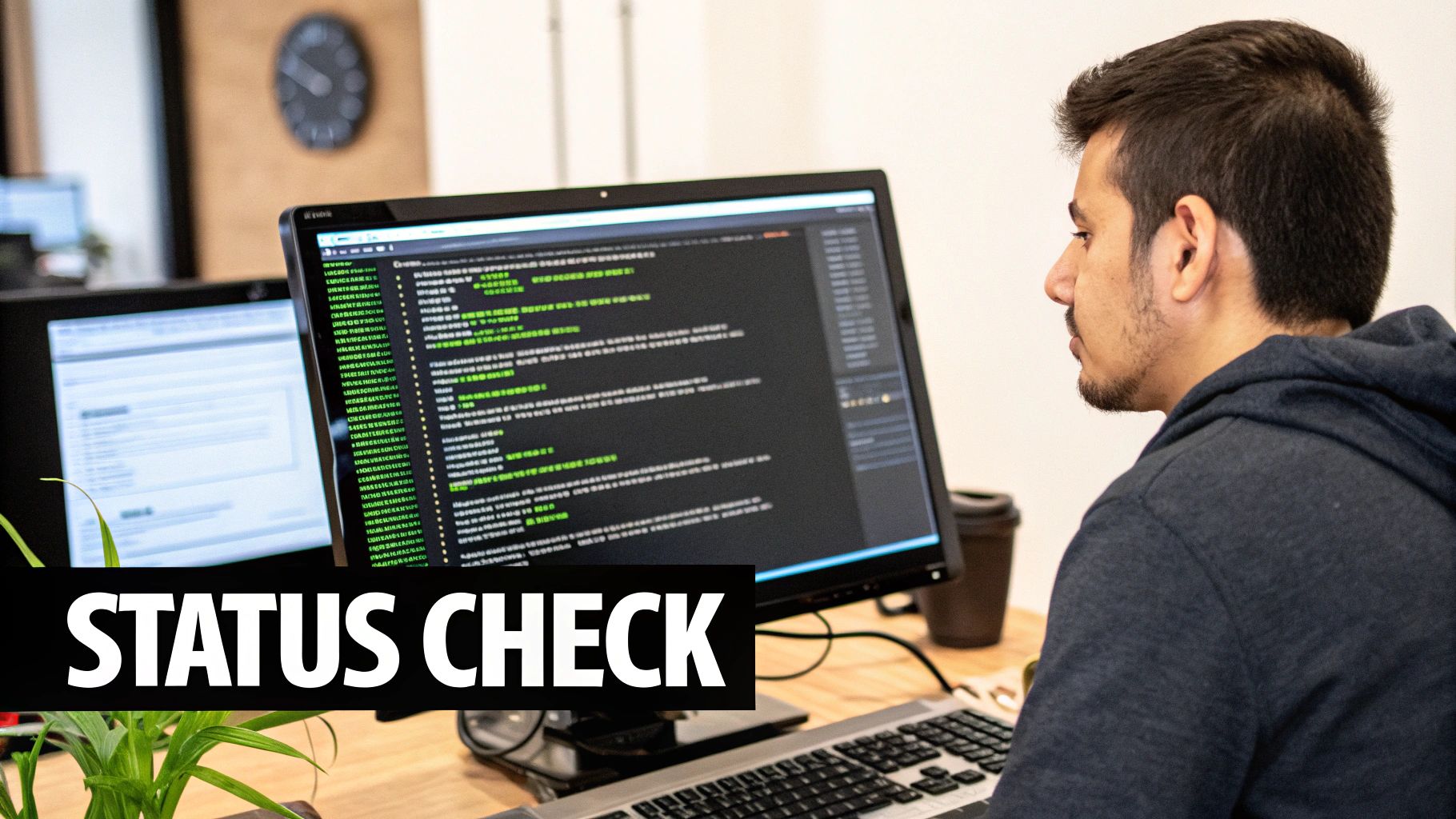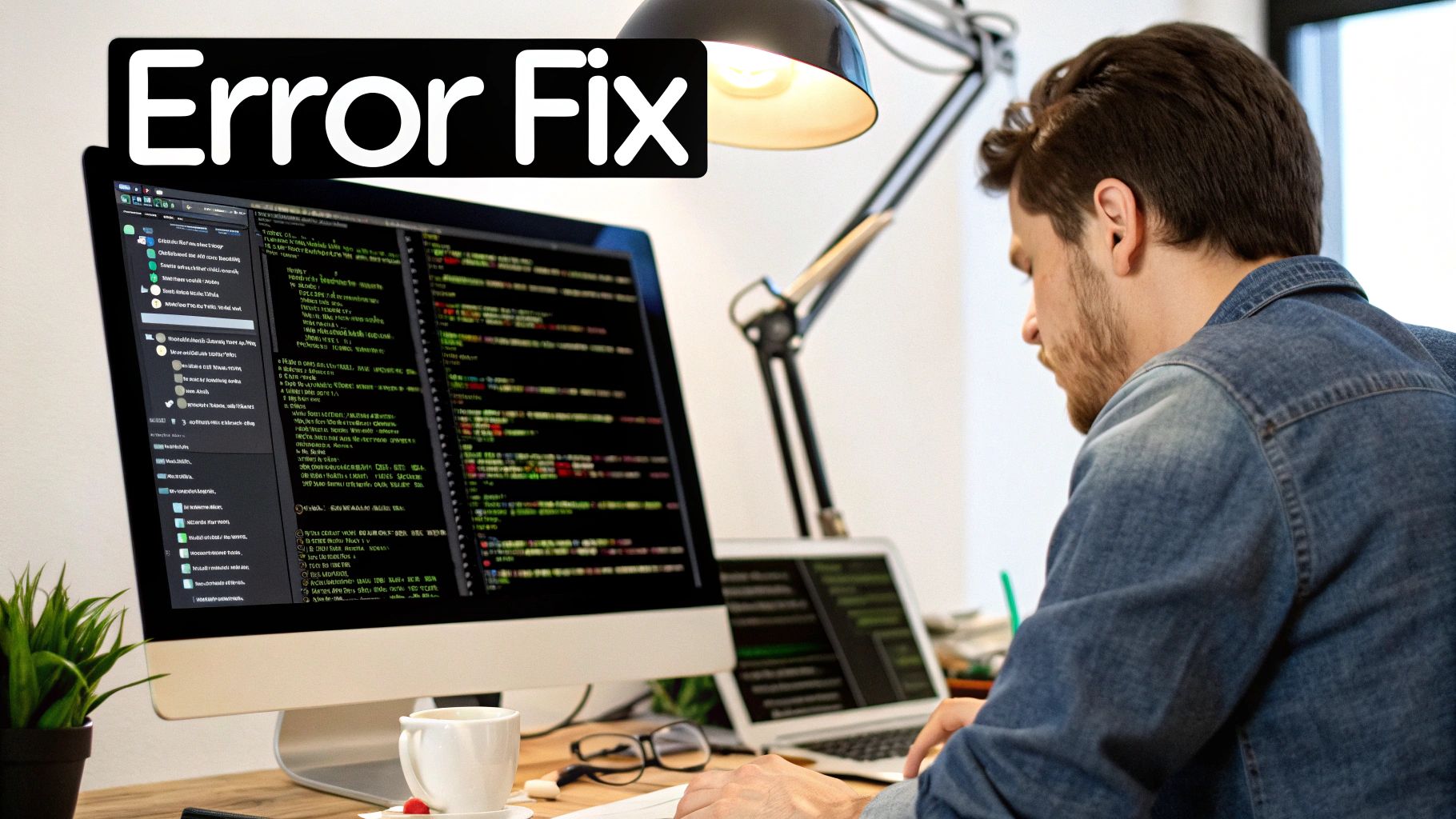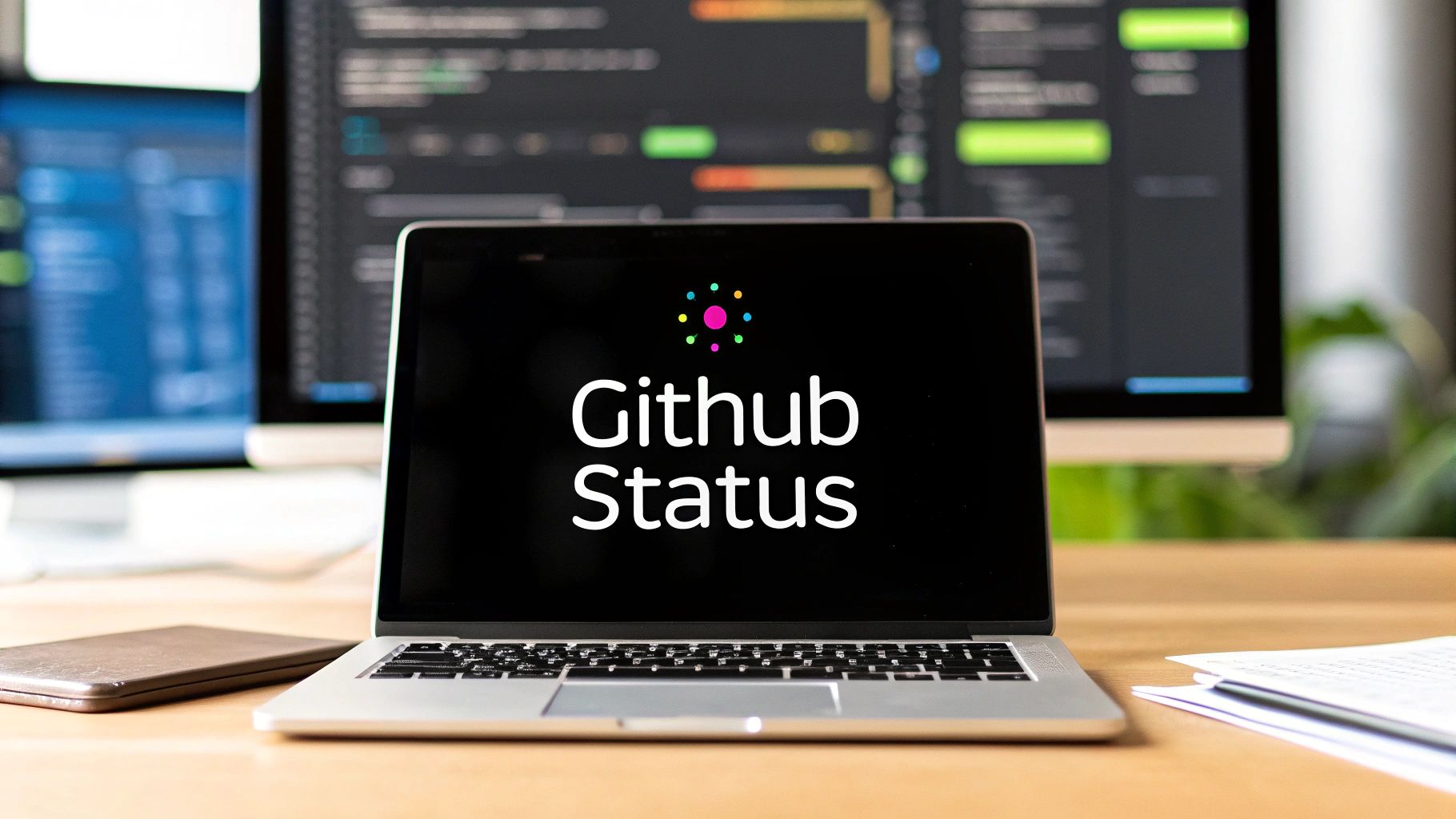Boost Code Quality with GitHub Status Check
The Power of GitHub Status Checks in Modern Development
Maintaining code quality across a team of contributors can be challenging. How can you ensure everyone adheres to best practices and minimizes bugs? GitHub status checks provide a robust solution, acting as your initial line of defense. They validate code changes before they impact your codebase, preventing errors that lead to frustrating debugging sessions. These checks aren't bureaucratic obstacles; they are valuable quality gates, ensuring your code meets established standards.
This system uses three key states: pending, passing, and failing. Think of them as traffic signals for your code. "Pending" means the check is still running, like a yellow light. "Passing," your green light, signals the code is good to go. "Failing," the red light, indicates a problem requiring immediate attention before merging. These signals are readily visible in your workflow, providing immediate feedback and preventing faulty code from progressing.
This transparent process streamlines development. If a test suite fails, the developer receives immediate notification and can address the issue quickly. This rapid feedback loop prevents small issues from becoming larger, more complex problems. Status checks also empower teams to identify and address vulnerabilities early in the development process. Want to learn more? Check out this comprehensive guide: How to master GitHub Status Checks.
Understanding the Mechanics of GitHub Status Checks
GitHub status checks are crucial for ensuring code quality and repository integrity. These checks rely on external processes, like continuous integration builds, triggered with every push to the repository. As mentioned, these checks appear as pending, passing, or failing next to individual commits within pull requests. Learn more about status checks. Anyone with write access to a repository can update a status check's state. Required status checks must pass before merging into a protected branch, guaranteeing a baseline level of code quality and security.
Gradual Integration for Maximum Impact
Implementing status checks shouldn't be disruptive. Start with essential checks, like basic linting and unit tests. As your team adapts, gradually introduce more complex checks, such as integration or end-to-end tests. This incremental approach minimizes disruption and allows your team to appreciate the benefits of status checks without feeling overwhelmed. By fostering a collaborative process, you can cultivate a culture of quality and continuous improvement. This ensures status checks improve, rather than impede, your team's development velocity.

Implementing GitHub Status Checks That Actually Work
Now that we understand the importance of GitHub status checks, let's discuss how to implement them effectively. A good setup balances comprehensive checks with a smooth developer experience. This means choosing integrations that add real value and avoiding those that slow down the development process.
Connecting Your CI Services
Integrating popular CI services like Jenkins, CircleCI, and GitHub Actions is a critical step. Each service offers unique benefits and integration methods. For instance, GitHub Actions is tightly integrated with GitHub, offering streamlined workflow definitions right within your repository. Jenkins is known for its flexibility and can trigger builds and update status checks based on a variety of events. CircleCI is a cloud-based solution with robust features for building, testing, and deployment. Selecting the right tool depends on your specific needs and existing infrastructure.
To help you choose, here's a quick breakdown of each service:
- Jenkins: Offers maximum flexibility but requires more setup.
- CircleCI: A cloud-based option with a relatively simple integration process.
- GitHub Actions: Provides seamless integration within the GitHub environment.
For additional insights on improving code quality, check out this helpful resource: How to master code quality improvements.

Required vs. Informational Checks
Not every check needs to be mandatory. Separating required checks from informational checks creates a better developer experience. Required checks, such as compilation and core tests, must pass before merging. These are your essential quality gates. Informational checks, like code style or performance benchmarks, provide useful feedback without blocking the merge process. Required checks are non-negotiable, while informational checks offer suggestions for improvement. This approach avoids development bottlenecks while promoting best practices.
The following table provides a comparison of some leading CI/CD tools and their GitHub integration capabilities:
"CI/CD Tools That Supercharge GitHub Status Checks" "A side-by-side comparison of leading CI/CD tools that integrate seamlessly with GitHub status checks, highlighting their strengths and implementation complexity"
| CI/CD Tool | Setup Complexity | GitHub Integration Features | Best For | |---|---|---|---| | Jenkins | More Complex | Highly Customizable Integrations | Teams needing maximum flexibility | | CircleCI | Relatively Simple | Cloud-based, good range of integrations | Projects seeking a balance of ease and features | | GitHub Actions | Seamless | Native integration, easy workflow definitions | Projects already heavily invested in the GitHub ecosystem |
This table highlights the varying levels of complexity and integration features offered by different CI/CD tools, helping you make an informed decision. Choosing the right tool often depends on your team's existing infrastructure and desired level of customization.
Scaling Your Configuration
A well-designed status check system can scale from small projects to large enterprise environments. For smaller projects, a few key checks might be enough. As your project and compliance requirements grow, your status check configuration should adapt as well. This might include multi-stage verification, context-aware checks, or custom validations. Clear documentation and standardized templates become essential to manage the growing complexity as your team and codebase expand. This approach ensures consistency and clarity across your organization.
Bulletproof Code With Status Checks and Protected Branches
Status checks become significantly more powerful when used with protected branches. This combination creates a strong defense for code quality. Leading engineering teams use this approach to maintain high standards without slowing down their development process. This section explores practical strategies for setting up branch protection rules that work well with your GitHub status checks, resulting in effective quality control measures that teams will appreciate.
Establishing Effective Branch Protection Rules
Think of protected branches as the ultimate safety net for your most important code, typically your main or release branches. Branch protection rules let you specify which status checks must pass before any code is merged. This helps prevent accidental or unauthorized changes to critical code.
For example, you can require all unit tests to pass and all code reviews to be completed before merging a pull request into your main branch. This ensures that all code entering your main branch meets a baseline quality level.
This isn't just about security. It’s also about ensuring code stability. By blocking merges until specific requirements are met, you reduce the risk of introducing bugs and regressions. This leads to fewer production problems, less time spent fixing urgent issues, and more productive, happier development teams.
Balancing Rigor and Efficiency
Finding the right balance between strictness and a smooth workflow is key to successful branch protection. While thorough checks are important, overly strict rules can slow things down. Consider the size and complexity of your project.
A small project might need fewer, simpler checks, while a large enterprise project with stringent compliance requirements will need a more comprehensive set of status checks. For instance, if a repository needs a specific build check to pass before merging, the GitHub status check will block the merge until the build is successful. This ensures only validated code is added to the main branch, minimizing errors. GitHub keeps this check data for 400 days, after which it’s archived and eventually deleted. Learn more about status checks.
Handling Urgent Situations
Sometimes, you need to be flexible. While maintaining high standards is crucial, emergencies do happen. For urgent hotfixes, consider allowing overrides for specific branch protection rules, but with proper approvals.
This enables quick responses to critical issues while still maintaining oversight and accountability. Keeping a record of these overrides is important for auditing and future review, ensuring transparency and responsible use of this flexibility.
Gradual Implementation in Existing Projects
Adding branch protection to an existing project should be a gradual process. Start by protecting your most important branches and implementing a few essential status checks. As your team adjusts, you can extend protection to other branches and gradually add more checks.
This incremental approach minimizes disruptions to ongoing work and lets teams adapt to the new procedures smoothly. It also creates an opportunity for feedback and continuous improvement, leading to a more refined and effective system.

Leveraging Pull Checklist for Enhanced Protection
Tools like Pull Checklist, found on the GitHub Marketplace, can significantly improve your branch protection strategy. Pull Checklist lets you create required tasks within pull requests. This helps ensure important steps, such as updating documentation or following specific testing procedures, aren't overlooked.
This adds another layer of quality control beyond automated checks, guaranteeing a thorough review. By automating and streamlining code reviews with conditional checklists, Pull Checklist enforces blocking and audit checks directly within pull requests. This strengthens the connection between status checks and branch protection, creating a truly robust workflow. This combination greatly enhances code quality while simplifying management of complex projects.
Data-Driven Insights From Status Check Analytics
Effective GitHub status checks are more than just a gatekeeping mechanism. They're a valuable source of data that can drive continuous improvement in your development practices. Top-performing teams don't just implement status checks; they analyze the results. This helps gain actionable insights and enhance their overall performance. It involves identifying patterns in failure rates, optimizing pipelines based on real metrics, and making informed decisions about your CI/CD process.
Using Data to Optimize Your CI/CD Pipeline
Analyzing status check data can reveal bottlenecks and inefficiencies in your development pipeline. For example, a consistently failing check might indicate a flaw in the test itself. It could also point to a recurring coding issue or a problem with the underlying infrastructure.
Tracking the duration of each check can help identify slow tests. These slow tests can hold up the development process. This allows teams to target specific areas for improvement, resulting in faster build times and a more streamlined workflow. Addressing these issues can significantly reduce build times. This leads to faster release cycles and increased developer productivity.
Catching Issues Early Through Trend Analysis
Regularly reviewing status check data allows you to identify trends in failure rates. An increasing trend might signal a growing problem in your codebase or development practices. For instance, if a previously stable check begins to fail more frequently, it could be an early warning sign. This early warning could indicate a deeper issue that requires attention.
Addressing these problems early can prevent them from escalating. Catching them early keeps small problems from turning into larger, more complex issues down the line. This proactive approach can save significant time and resources in the long run. Using data to anticipate potential problems allows teams to shift from reactive firefighting to proactive problem-solving.
Improving Developer Productivity Through Meaningful Feedback
Status checks provide crucial feedback to developers. This helps them catch and fix errors early in the development cycle. However, this feedback is only useful if it’s clear and actionable. This is where analytics come in.
By analyzing which checks are failing most often and why, you can provide targeted training and support to developers. This improves their skills and reduces error rates. It empowers developers to learn from their mistakes and continuously improve their coding practices. Understanding repository activity in a broader context is key to optimizing status checks. GitHub provides tools like Pulse and the activity view to analyze repository activity. Pulse offers an overview of pull requests, issues, and commit activity. The activity view offers a more granular look at repository events. Learn more about repository activity analysis.
Visualizing and Communicating Insights
Data is most effective when it's clearly communicated. Visualizing status check analytics through dashboards and reports can help teams understand trends. It can also help identify areas for improvement. Sharing these insights across the engineering team promotes transparency. It fosters a shared understanding of quality goals. This collaborative approach encourages continuous improvement. It also helps build a culture of quality within the organization. Tools like Pull Checklist can augment this process. They can offer valuable data on checklist completion rates and common roadblocks. This provides further insights for optimizing your workflow. This data-driven approach helps to ensure that status checks are a valuable tool for improving code quality, not a source of frustration for developers.

Troubleshooting GitHub Status Checks Like a Pro
Even the smoothest-running GitHub status checks can occasionally throw a wrench in the works. Drawing on insights from seasoned DevOps engineers, we'll explore common sticking points and offer practical solutions. This section focuses on diagnosing and resolving stalled checks, unexplained failures, integration hiccups, and permission issues that can disrupt your workflow.
Diagnosing Stalled Checks
A stalled check shows up as "pending" indefinitely, halting any forward momentum. This often stems from a problem with the external service responsible for running the check. A good first step is to check the service's status page for any reported outages or performance degradation. If the service appears to be functioning normally, then investigate your CI/CD tool’s configuration. A misconfigured webhook or a network issue could also be the culprit. For instance, if you're using GitHub Actions, carefully review your workflow file for errors and ensure it’s configured to trigger on the correct events.
Deciphering Mysterious Failures
Mysterious failures, where a check fails without providing a clear reason, can be particularly perplexing. Your initial step should be to thoroughly examine the logs from your CI/CD service. These logs often contain valuable breadcrumbs. If the logs don’t shed enough light, try running the check locally to recreate the failure in a controlled environment. This often uncovers environment-specific issues or hidden dependencies that might not be immediately apparent within the CI/CD environment.
Resolving Integration Disconnects
Integration problems between GitHub and your CI/CD tool can present themselves in different ways, like checks not triggering or incorrect status updates. Double-check that the webhook between GitHub and your CI/CD tool is properly configured. Ensure the webhook’s payload includes all the necessary information for triggering the checks. Also, verify that the CI/CD tool has sufficient permissions to interact with the GitHub repository. Insufficient permissions can prevent the tool from updating status checks as it should.
Addressing Permission Problems
Incorrectly set permissions can also cause status checks to malfunction. Make sure all users involved in the development process have the required permissions for both the repository and the CI/CD tool. If a check needs access to specific resources, ensure the CI/CD tool’s service account has the appropriate credentials. For sensitive operations, consider implementing fine-grained access tokens to restrict the CI/CD tool’s access to only what is necessary.
Preventative Measures for Smoother Workflows
Taking proactive steps can greatly minimize future disruptions. Consider these strategies:
-
Regularly monitor your CI/CD services: This helps catch potential issues early on, before they snowball into bigger problems.
-
Thoroughly test your CI/CD configuration: Identify and address any configuration issues before they disrupt your development workflows.
-
Implement robust error handling in your CI/CD pipelines: Clear and informative error messages are essential for rapid troubleshooting.
The following table summarizes the common issues, their root causes, troubleshooting steps, and preventative measures:
| Issue | Common Causes | Troubleshooting Steps | Prevention Tips | |---|---|---|---| | Stalled Check | External service outage, misconfigured webhook, network problems | Check service status page, review CI/CD configuration, inspect workflow files | Monitor CI/CD services, thoroughly test configurations | | Mysterious Failure | Unclear error messages, environment-specific issues, hidden dependencies | Examine CI/CD logs, reproduce failure locally | Implement robust error handling, thorough testing | | Integration Disconnect | Misconfigured webhook, insufficient permissions | Verify webhook configuration, confirm CI/CD tool permissions | Test integrations regularly | | Permission Problems | Incorrect user permissions, insufficient service account credentials | Verify user access, confirm service account credentials, use fine-grained access tokens | Regularly audit permissions |
This table provides a quick reference for addressing typical GitHub status check issues. By implementing these techniques, you can ensure your GitHub status checks function reliably, contributing to a more efficient and robust development workflow. Using tools like Pull Checklist can further enhance your workflow, ensuring all essential tasks are completed before merging code and complementing your status check strategy.
Advanced Status Check Strategies From Elite Teams
Building upon a solid foundation of basic GitHub status checks, high-performing engineering teams use advanced strategies to turn these checks into powerful quality tools. This moves beyond simple pass/fail results and explores sophisticated approaches that adapt and grow alongside the codebase.
Context-Aware Checks
One key strategy is using context-aware checks. These checks change based on the size of the proposed updates. For example, a small update to documentation probably doesn't need the same level of testing as a major code rewrite. By adjusting the checks to the specific situation, you can avoid unnecessary work and focus testing where it's most important. This smart approach streamlines development without sacrificing quality. It allows teams to apply the appropriate level of review, balancing speed and thoroughness. You might be interested in: How to master Code Review Best Practices.
Custom Validations for Unique Project Needs
Every project has its own unique requirements. Custom validations let you address these specific needs by creating checks tailored to your exact specifications. This could include checking for specific coding styles, enforcing internal security rules, or verifying compliance with industry standards. This ensures consistency across your project and reinforces your development standards. This flexibility lets teams enhance the functionality of standard status checks and build a quality assurance process aligned with their project's goals.
Multi-Stage Verification
Another effective strategy is multi-stage verification. This breaks down the verification process into separate stages. Each stage might focus on a different aspect of code quality, from basic code formatting and unit tests to integration testing and security checks. This allows for a more detailed approach to quality control. Early stages can quickly catch simple errors and provide fast feedback to developers. Later stages perform more complex testing, ensuring all code meets high standards before release. This approach balances speed with the need for comprehensive testing.
Automated Status Check Management
Leading teams often use automated status check management. As projects expand, so does the complexity of their status check settings. Automated tools and scripts can help manage this complexity, ensuring checks stay relevant and efficient. These tools can automatically update settings based on code changes, team needs, or even external issues like security vulnerabilities. This proactive approach ensures your GitHub status check system grows with your codebase, providing ongoing value without becoming difficult to maintain. For example, by looking at the activity view, developers can see how status checks have affected the merge history of their repository, helping improve workflows. Explore this topic further: Learn more about repository activity analysis.
Integrating Status Checks Into Your Quality Culture
Top engineering teams know that GitHub status checks aren't just a technical tool; they're a core part of their quality culture. By integrating these checks into their workflow, teams build a shared commitment to code quality and create a feedback-rich environment. This promotes continuous improvement and encourages developers to take responsibility for code quality. This contributes to a higher standard of engineering. This leads to more robust, reliable, and maintainable software. Tools like Pull Checklist improve this process by adding a human element to automated checks. By integrating required checklists into pull requests, teams reinforce best practices and encourage careful reviews, further strengthening a culture of quality.
Status Check Success: Practices That Actually Scale
This final section offers practical advice from teams who have successfully implemented GitHub status checks across various projects and team structures. We'll explore how to create checks that provide valuable feedback without slowing down development. This means balancing thorough validation with performance, and designing checks that improve the developer experience. Ultimately, it's about integrating status checks into your overall quality assurance process.
Balancing Validation and Performance
Thorough code validation is essential, but it shouldn't sacrifice speed. One effective strategy is to prioritize your checks. Start by focusing on the most critical aspects of your codebase. For example, security checks and tests covering core functionality should be prioritized. Less critical checks, such as style guidelines, can run asynchronously or at less frequent intervals. This risk-based method ensures that essential validations are performed quickly, maintaining a smooth development process.
Designing Checks for a Better Developer Experience
Status checks should be helpful, not a hindrance. Clear, concise error messages are key. When a check fails, developers need to immediately understand why it failed and how to resolve the issue. Vague or unhelpful error messages waste time and lead to developer frustration. Also, make sure your checks run quickly. Long wait times disrupt workflow and reduce productivity. Ideally, aim to keep individual checks under a few minutes whenever possible.
Integrating With Your Broader QA Ecosystem
GitHub status checks are most powerful when part of a larger quality assurance strategy. This may include code reviews, automated testing, and manual QA processes. Connecting these elements creates a robust system that catches errors at multiple stages of development. This layered approach helps identify issues early, before they impact users. For instance, using required checklists in pull requests, like those offered by Pull Checklist, enhances automated status checks. This reinforces essential review steps, further strengthening your QA strategy.
Team Communication and Onboarding
Effective communication is critical for successful status check implementation. Clearly document your status check process, explaining the why behind each check and what it verifies. This helps developers understand the purpose of the checks and encourages adoption. When onboarding new team members, dedicate time to explaining the status check process. Make sure they know how to interpret results and what actions to take if a check fails. This proactive communication promotes consistency and reduces errors caused by misunderstandings.
Raising Your Quality Standards
Continuously improving quality should be an ongoing process. Regularly review your GitHub status check configuration. Are there any checks consistently failing or providing minimal value? Are there new checks you could add to address emerging issues? This iterative approach ensures your status checks stay relevant and effective, maintaining high code quality as your project grows. Involving the development team in this process fosters ownership and promotes continuous improvement within the team. This collaborative approach creates a positive feedback loop, driving higher quality and better development practices.
Boost your team's code review process with Pull Checklist, a powerful GitHub app that streamlines code reviews through automated, conditional checklists. Learn more about how Pull Checklist can elevate your code quality.
